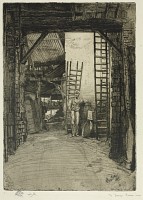KEYWORD
barrel, barge, cart, interior, ladder, man standing, passageway, portrait, river, street, warehouse, wharf, worker.
TITLE
There are several forms of title, those that name the main figure, or his job, or the generic trade, as well as variations in grammar and punctuation, as follows:
'
W. Jones, Lime-burner, Thames Street' (1860, R.A.)
1
'
The Lime-Burner' (1871, Ellis & Green).
2
'
Thames Limeburners' (1870s, Whistler).
3
'
The Lime Burners' (1874,
Ralph Thomas, Jr (1840-1876)).
4
'
The Limeburner’s Yard' (1874, Whistler).
5
'
The Lime-Burner' (1886,
Frederick Wedmore (1844-1921)).
6
'
Limeburners' (1887, Whistler).
7
'
Lime burners' (1887/1888, Whistler).
8
It is assumed that Whistler provided the information for the title used at the Royal Academy in 1860 and although he did not use this title again, it is accurate.
However, the title '
The Lime-Burner' as published in 1871 is the preferred title, and accepted by most later cataloguers.
DESCRIPTION
A heavily timbered square entrance leads into the lime-burner's premises. To right of centre, in front of two ladders propped against a white wall, the lime-burner stands leaning on a barrel, with more barrels, a large sieve and two more ladders to the right. He wears a flat cloth cap, and a waistcoat with lapels over a shirt and loose trousers. To the left there is a dismantled cart and cart-wheel, in front of a complex of wooden pillars, rafters and sloping roofs. To right of this, a passage leads through to the wharf itself. At the end a figure sits facing left, in the shade of partly raised shutters. A barge is just visible, moored by the wharf. Beyond is a glimpse of the river, with the masts of shipping and warehouses on the far side.
SITTER
The etching was exhibited in 1860 with the name and address of the central figure, 'W. Jones, Lime-burner, Thames Street.' 9 William Jones & Co. were at 241 and 242 Wapping High Street, which backed onto East London Lime Wharf. 10
Lime is the chief ingredient of mortar and plaster, and is also used to condition the soil. The lime-burner burnt limestone, shells, chalk etc. in a kiln to make lime (calcium oxide, an alkaline inorganic compound of calcium). The lime was slaked with water to produce quick-lime (calcium hydroxide) - a highly caustic alkaline. This was a dangerous occupation. Lime-burners risked carbon-monoxide poisoning, severe burns and an early death. There is a curious parallel with Whistler's profession - the effect of the dilute acid used for etching the plates is conspicuous in the foul biting in his etching of The Lime-burner.
9:
London RA 1860
.
10: Street directory, London Postal Directory, 1859.
SITE
This shows the lime-burner's premises at 241 and 242 Wapping High Street, looking through to East London Lime Wharf and the River Thames.
There were lime kilns and lime works all over London, often near the Thames or other waterways, which aided transport of the chalk, the coal for the kilns, and the finished product.
In his Thames etchings Whistler focussed on the area of docks from East London Lime Wharf, past the entrance to the Thames Tunnel, Tunnel Steam Packet Pier, Wapping Dock Stairs, Wheatsheaf Wharf (at No. 233 Wapping High Street), Shap's wharf, Execution Dock Stairs, Phoenix Wharf, the Thames Police Station (at No. 255), Aberdeen Steam Wharf (at No. 257), Baltic Wharf (Tyzack Whitely & Co. at Nos. 266-67), Eagle Wharf (at No. 269), Hermitage Wharf (at No. 343), Watson's Wharf, and Hore's Wharf. 11
DISCUSSION
Whistler used the device of frames within frames to emphasize spatial recession, possibly influenced (as were other artists in Europe in the 1850s, including
François Bonvin (1817-1887)) by paintings like the
The Courtyard of a House in Delft
(1658) by the Rotterdam painter Pieter de Hooch (1617-1684).
12 Lochnan comments that Whistler was also developing compositional themes that were originally seen in his work in the 'French Set':
12: National Gallery, London, bought 1871.
'With its succession of open and closed spaces, alternately light and dark, leading the eye deeper and deeper into the composition, it recalls the paintings of de Hooch. This method of constructing picture space in depth using receding archways or doorways was to become a recurring "theme" in Whistler's etched work.' 13
Fore-runners of this composition in Whistler's work include
La Marchande de Moutarde
[20], which is reproduced below:

It became a recurring compositional device: later works with strong similarities include
The Doorway
[193], reproduced below:




